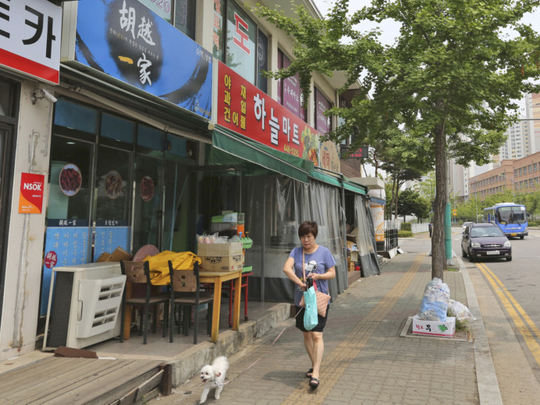
INCHEON, South Korea
The little restaurant isn’t much to look at. It’s across the street from an empty lot in a city where bland high-rise apartment buildings sprawl in every direction. Boxes of dried fish are stacked by the front window. A dirty mop stands in the corner. The walls are painted green.
But people come from across South Korea to eat here. They come for the potato pancakes, the blood sausage and, very often, for a fried street food that many dreamed of back when nearly everyone they knew was hungry. More than anything, though, they come for memories the food brings back of an outcast homeland they may never see again.
“This is the taste of where they came from,” says the restaurant’s owner, a refugee who asks to be identified only by her surname, Choi. “The food here tastes the way it does in North Korea.”
Missing North Korea
More than 30,000 North Koreans now live in South Korea, having fled poverty, hunger and the relentless pressures of life in an oppressive, authoritarian state. But for most, life in the South is far from ideal. Raised amid dictatorial dysfunction, and normally poorly educated, the exiles stumble into a brutally competitive nation where they are regularly disdained by their neighbours.
“Chon-nom” they are often called — “bumpkin.” That derision, combined with their own disillusionment, can churn into a stew of suspicion, resentment and ambivalence. And though they may hate the nation they left behind, many also miss it deeply. Because how can you not miss home?
“Our lives here can be so difficult,” said a North Korean now living in the South. “But finding that restaurant made me so happy.”
She spoke on condition her name not be used — even North Koreans who fled years ago remain concerned about reprisals against them or relatives still in the North.
Choi has built them a tiny island of North Korean life that starts to feel crowded if it has more than a half-dozen customers. In a burst of optimism she named it Howol-ilga, “People from Different Homelands Come to Gather in One Place.”
“My place is a comfort for them,” says Choi, 39, in a Northern accent so thick it can be barely comprehensible at first to Southerners. “When they come here and find a menu so similar to what they ate back home, they know they can relax.”
At first glance Choi doesn’t seem very relaxing. Gruff and often scowling, restaurant work has left her hands patterned with small knife cuts and her forearms spattered by ugly oil burns. She has only two employees, and keeps the restaurant open seven days a week. Exhaustion is a constant. She cannot remember her last day off.
But eventually — when she finally sits down to talk, chugging a can of Georgia Original coffee — a smile crosses her face.
Growing up in North
Choi grew up in a small town so close to North Korea’s Amnok River border that you could wave to people in China. She learnt cooking from her father, a one-time military cook who loved working in kitchens — rare in the North’s deeply conservative culture — and from relatives who smuggled in goods from China. “They had learnt Chinese cooking there,” she said.
The family was far from rich, but made enough trading in clothes, cheap electronics and DVDs of South Korean TV shows to count as middle-class. It was enough to avoid the horrors of North Korea’s mid-1990s famine, which killed at least 500,000 people and perhaps well over a million. Years later, most North Korean refugees still refer to the famine by its Pyongyang-mandated euphemism.
“Even in the Arduous March we didn’t suffer much,” Choi says, shrugging. “It’s my family’s fate to escape living in poverty.”
She left the North in 2012, looking for a better life for her young son, and opened the restaurant two years later. Modesty isn’t an issue for her.
“All of my customers talk about how good I am,” she says. “They tell me: ‘When I eat in other restaurants, it doesn’t taste like what I used to eat in the North. What you cook tastes completely different!’”
A South Korean, she insists, could never succeed in her kitchen.
“A cook’s appetite is different” when they come from another place, she says, leaning against one of her fake wood tables. “They taste things in a different way. So how could they cook this kind of food?”
— AP












